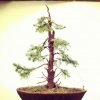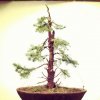You are using an out of date browser. It may not display this or other websites correctly.
You should upgrade or use an alternative browser.
You should upgrade or use an alternative browser.
Newbie Alberta Spruce: I know a worthless cause...
- Thread starter Emrys
- Start date
ABCarve
Masterpiece
What kind of pot is that, that you can drive a nail into it?
Emrys
Mame
What kind of pot is that, that you can drive a nail into it?
It's a wood bowl that I drilled a bunch of drain holes in.
october
Masterpiece
I actually don't think it is that bad if it came from the typical home improvement store. There is only so much you can do. Also, if you need to work on your bonsai skills, then this is good practice. In regards to the apex, the top pad of foliage. Did you leave some cambium and bark in the back that leads up to that tuft? I ask because I noticed the carving underneath it. If it is carved all the way around, the life line, so to speak, has been severed and that section will die.
Rob
Rob
JudyB
Queen of the Nuts
I had several of these over the years, they are really great trees to learn how to wire on. Because they don't hold their shape long, you have to constantly re-wire them, and re-wire them... So don't worry if it's not the penultimate bonsai subject, just learn what you can learn on it. Thanks for sharing it with us.
Poink88
Imperial Masterpiece
Be prepared for it to eventually rot and disintegrate. How long depends on what kind of wood it is made of and how it was treated/finished.It's a wood bowl that I drilled a bunch of drain holes in.
I agree with Rob on all points. Good job!I actually don't think it is that bad if it came from the typical home improvement store. There is only so much you can do. Also, if you need to work on your bonsai skills, then this is good practice. In regards to the apex, the top pad of foliage. Did you leave some cambium and bark in the back that leads up to that tuft? I ask because I noticed the carving underneath it. If it is carved all the way around, the life line, so to speak, has been severed and that section will die.
Rob
Emrys
Mame
I actually don't think it is that bad if it came from the typical home improvement store. There is only so much you can do. Also, if you need to work on your bonsai skills, then this is good practice. In regards to the apex, the top pad of foliage. Did you leave some cambium and bark in the back that leads up to that tuft? I ask because I noticed the carving underneath it. If it is carved all the way around, the life line, so to speak, has been severed and that section will die.
Rob
Thanks Rob and Judy. I do need to work on my skills as I don't have any yet. Thus the 25 $ Alberta Spruce I bought as our families Christmas tree this year. We are Jewish.
I have been itching for something to work on that doesn't have serious consequences. I am not expecting much out of this other than using it as learning material.
Rob. I did leave a live vein to the top branch. Lets see if this tree pushes new growth in the spring.
ABCarve
Masterpiece
I had several of these over the years, they are really great trees to learn how to wire on. Because they don't hold their shape long, you have to constantly re-wire them, and re-wire them... So don't worry if it's not the penultimate bonsai subject, just learn what you can learn on it. Thanks for sharing it with us.
Has anyone ever tried cutting a wedge out from under the branch close to the trunk to pull it down?? When it's pulled the cadmium lines up and it will fuse back to together. I think it would be a more permanent solution. I've done it to a number of tree and haven't lost a branch yet.
Attachments
Last edited:
RichKid
Shohin
I was just thinking about Alberta Spruce. Would it be completely anathema to leave it more natural looking? Like a little fuller with the pyramidical shape?
JudyB
Queen of the Nuts
Take a look at what Harry Harrington did with this species, if you haven't seen it yet...
His group is what inspired me to work with some of these.
http://www.bonsai4me.com/AdvTech/ATpiceagroupstyling.htm
His group is what inspired me to work with some of these.
http://www.bonsai4me.com/AdvTech/ATpiceagroupstyling.htm
Emrys
Mame
Take a look at what Harry Harrington did with this species, if you haven't seen it yet...
His group is what inspired me to work with some of these.
http://www.bonsai4me.com/AdvTech/ATpiceagroupstyling.htm
Yes I have read and reread almost every article on Harry's website. Starting many years ago before attempting to practice. I find his writing and teaching style to be very accessible. I'm a fan!
KennedyMarx
Omono
Yes I have read and reread almost every article on Harry's website. Starting many years ago before attempting to practice. I find his writing and teaching style to be very accessible. I'm a fan!
I just got his first book (Bonsai Inspirations I) and it's great. It's written exactly like his site, but it's full of developmental demonstrations with several years of each tree displayed so you can really get a feel for how they react to being altered. I definitely recommend it.
Emrys
Mame
I just got his first book (Bonsai Inspirations I) and it's great. It's written exactly like his site, but it's full of developmental demonstrations with several years of each tree displayed so you can really get a feel for how they react to being altered. I definitely recommend it.
Where did you find it? Isn't it out if print? I have his second one.
KennedyMarx
Omono
You can get it through his site or Amazon.com, which is where I got the Kindle version.
monza
Shohin
I just emailed Harry regarding his Alberta Spruce to see if he has any progression pics of the grouping. Wonder if he'll reply? I'd take a wild guess that there was some serious losses from the radical treatment those trees went through. I'll probable try my skills or lack of on a few this spring.
rockm
Spuds Moyogi
"I'd take a wild guess that there was some serious losses from the radical treatment those trees went through."
Maybe not. A. spruce is tough, extremely tough. I finally threw a few out after working on them for 15 years. I let them dry out, I butchered them every five years or so. Mangled their roots. overwatered them. They didn't care....
THey are very difficult to keep looking in any decent shape. The upright branching is the primary problem. Wounding branches near their emergence from the trunk, bending them down severly and allowing the callus tisssue to hold them there is the only real way to get them to stay down for any reasonable amount of time. That will only get you about three years worth of hold, though, as all ensuing growth goes UP past the wound. It's frustrating, but this kind of tree can teach you a lot about what you can do with more advanced artistic techniques
Maybe not. A. spruce is tough, extremely tough. I finally threw a few out after working on them for 15 years. I let them dry out, I butchered them every five years or so. Mangled their roots. overwatered them. They didn't care....
THey are very difficult to keep looking in any decent shape. The upright branching is the primary problem. Wounding branches near their emergence from the trunk, bending them down severly and allowing the callus tisssue to hold them there is the only real way to get them to stay down for any reasonable amount of time. That will only get you about three years worth of hold, though, as all ensuing growth goes UP past the wound. It's frustrating, but this kind of tree can teach you a lot about what you can do with more advanced artistic techniques
Last edited:
monza
Shohin
Harry replied, which I think is cool, see below:
Hi Harry
Thanks for your site, lots of valuable information and great articles!
Curious if these tree's http://www.bonsai4me.com/AdvTech/ATpiceagroupstyling.htm survived and if you still have the grouping? Photos then where form 2006.
Thanks Very Much!
Dave
_______________________
Hi Dave,
(I've regretted it since many times) The Spruce group was sold not long after I put it together, for a price I couldn't resist, stupidly. The buyer didn't want the pot so I got to keep that into the bargain!
Thank you for your kind comments.
Harry
----------------------------
Hi Harry
Thanks for your site, lots of valuable information and great articles!
Curious if these tree's http://www.bonsai4me.com/AdvTech/ATpiceagroupstyling.htm survived and if you still have the grouping? Photos then where form 2006.
Thanks Very Much!
Dave
_______________________
Hi Dave,
(I've regretted it since many times) The Spruce group was sold not long after I put it together, for a price I couldn't resist, stupidly. The buyer didn't want the pot so I got to keep that into the bargain!
Thank you for your kind comments.
Harry
----------------------------
Brian Van Fleet
Pretty Fly for a Bonsai Guy
Has anyone ever tried cutting a wedge out from under the branch close to the trunk to pull it down?? When it's pulled the cadmium lines up and it will fuse back to together. I think it would be a more permanent solution. I've done it to a number of tree and haven't lost a branch yet.
I've done this a few times. Here is one Peter Warren did on a black pine a couple years ago. He wasn't very concerned with the cambiums lining up, so he said, but it looks like they joined up anyway. My feeling is that this is effective, but not very natural-looking.
Kathy Shaner dislodges branches from the trunk (at the top, still joined at the bottom), to move them down, which is very natural looking. I have done this several times, it creates a nice line, interesting scars, and some nice exposed deadwood.
Attachments
rockm
Spuds Moyogi
I scarred the top of the Alberta Spruce branches--removed ALL the cambium from the top surface at the union with the trunk, out about an inch and a half--yanked them down, wired them and waited for the scar tissue.
Took about a year for enough to form to unwire the branches. The thicker scar tissue on TOP of the branch prevented the branches from springning back up.
Took about a year for enough to form to unwire the branches. The thicker scar tissue on TOP of the branch prevented the branches from springning back up.
Brian Van Fleet
Pretty Fly for a Bonsai Guy
I scarred the top of the Alberta Spruce branches--removed ALL the cambium from the top surface at the union with the trunk, out about an inch and a half--yanked them down, wired them and waited for the scar tissue.
Took about a year for enough to form to unwire the branches. The thicker scar tissue on TOP of the branch prevented the branches from springning back up.
interesting...effective? did it look good?
Similar threads
- Replies
- 5
- Views
- 180
- Replies
- 7
- Views
- 244
- Replies
- 50
- Views
- 986





